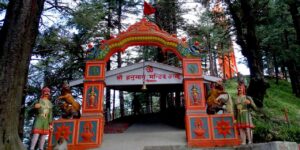Jakhu Temple, nestled on the majestic Jakhu Hill in Shimla, Himachal Pradesh, is a renowned Hindu temple dedicated to Lord Hanuman. With its spiritual significance, architectural charm, and panoramic views, Jakhu Temple attracts devotees and visitors from all corners of the globe. Let’s explore the temple’s history, architecture, religious importance, and its contribution to the cultural tapestry of Shimla.
Jakhu Temple holds a profound historical and mythological significance. According to ancient lore, it is believed that Lord Hanuman, in his search for the Sanjeevani herb during the epic Ramayana, paused at Jakhu Hill. Impressed by Lord Hanuman’s devotion and loyalty, Lord Rama blessed the site, sanctifying it as a sacred place. Thus, Jakhu Temple was built as a symbol of reverence to honor this divine connection.
The location of Jakhu Temple adds to its allure. Perched at an altitude of approximately 2,455 meters (8,051 feet), it stands as the highest peak in Shimla, offering breathtaking panoramic views of the cityscape, surrounding valleys, and snow-capped Himalayan peaks. The uphill journey to the temple, either through a picturesque trek or by a convenient ropeway, allows visitors to immerse themselves in the tranquil beauty of nature.
Architecturally, Jakhu Temple showcases a blend of traditional Himachali and North Indian styles. The temple structure predominantly features wooden craftsmanship, with intricate carvings and ornate pillars that exemplify the region’s artistic heritage. The detailed artwork depicts scenes from Hindu mythology, bringing the stories to life within the temple’s sacred walls.
At the heart of Jakhu Temple lies the iconic statue of Lord Hanuman, towering at a height of approximately 108 feet. This magnificent statue, one of the tallest Hanuman statues in the world, evokes a sense of reverence and awe. Lord Hanuman’s benevolent presence radiates serenity, inviting devotees and visitors to seek his blessings and experience spiritual solace.
The temple’s spiritual significance resonates deeply with devotees who flock to Jakhu Temple to pay homage and seek Lord Hanuman’s divine blessings. It is believed that worshiping at this sacred site bestows protection, strength, and fulfillment of desires. The serene ambiance and tranquil surroundings provide an ideal setting for devotees to connect with the divine, engage in prayer, and meditate in a peaceful environment.
One distinctive feature of Jakhu Temple is its resident monkey population. Considered sacred and believed to be descendants of Lord Hanuman, the monkeys roam freely around the temple premises. Observing their playful antics adds a unique charm to the temple experience. However, visitors are advised to exercise caution and maintain a respectful distance from the monkeys to ensure their safety and the preservation of harmonious coexistence.
Jakhu Temple holds a significant place in the cultural fabric of Shimla. It serves as a testament to the region’s religious heritage and acts as a center for cultural and social gatherings. The temple plays host to various religious ceremonies, festivals, and cultural events throughout the year. Hanuman Jayanti, the birth anniversary of Lord Hanuman, is celebrated with great fervor, attracting devotees who participate in religious rituals, devotional songs, and processions.
Apart from its spiritual importance, Jakhu Temple offers a mesmerizing vantage point to behold the natural beauty that surrounds it. Visitors are treated to awe-inspiring views of Shimla city, the lush valleys, and the majestic Himalayan peaks. The serenity of the hilltop and the breathtaking vistas create an atmosphere of peace and tranquility, inviting introspection and a deep appreciation for nature’s wonders.
History of The Jakhu Temple in Shimla:
The history of the Jakhu Temple in Shimla, Himachal Pradesh, dates back centuries and is intertwined with Hindu mythology and the epic Ramayana. According to ancient legends, Lord Hanuman, the devoted disciple of Lord Rama, visited Jakhu Hill during his quest for the Sanjeevani herb.
It is believed that Lord Hanuman rested on Jakhu Hill, which is now considered a sacred spot. His footprints were imprinted on a rock, and in time, a temple was constructed to honor his visit. The exact date of the temple’s establishment is unknown, but it gained prominence during the British colonial era in the 19th century when Shimla became the summer capital of British India.
During the colonial period, the British officials and residents developed an interest in exploring the natural beauty of Shimla and its surroundings. The Jakhu Temple, located atop Jakhu Hill, became a point of attraction for the British community due to its historical and spiritual significance.
Over the years, the temple underwent renovations and expansions to accommodate the growing number of devotees and visitors. The surrounding areas were developed to enhance accessibility and provide a pleasant environment for pilgrims.
Today, the Jakhu Temple stands as a revered place of worship and a symbol of faith. It attracts devotees and tourists from all over the world who seek blessings and spiritual solace. The temple’s association with Lord Hanuman, known for his strength, devotion, and loyalty, has made it a significant religious site.
The historical and cultural importance of the Jakhu Temple extends beyond its religious significance. It serves as a reminder of the rich heritage and mythology that has shaped the spiritual fabric of India. The temple’s location on Jakhu Hill, offering panoramic views of Shimla and the surrounding landscapes, adds to its allure and attracts visitors seeking both spiritual and natural beauty.
Attractions Point Of The Jakhu Temple:
The Jakhu Temple in Shimla, Himachal Pradesh, is not only a place of worship but also offers several attractions that enhance the overall experience for visitors. Let’s explore some of the key attractions and points of interest associated with the Jakhu Temple:
- Lord Hanuman Statue: The towering statue of Lord Hanuman is a major attraction at Jakhu Temple. Standing at a height of approximately 108 feet, it is one of the tallest Hanuman statues in the world. The statue’s majestic presence and serene expression captivate the attention of devotees and tourists, creating a sense of awe and reverence.
- Panoramic Views: Located atop Jakhu Hill, the temple offers breathtaking panoramic views of Shimla city, the surrounding valleys, and the snow-capped Himalayan peaks. Visitors can enjoy the scenic beauty and capture stunning photographs while taking in the serene ambiance.
- Scenic Trek: To reach the Jakhu Temple, visitors can embark on a scenic trek through the picturesque forests and winding paths of Jakhu Hill. The trek provides an opportunity to immerse oneself in nature’s beauty, witness diverse flora and fauna, and enjoy the tranquility of the surroundings.
- Wildlife Encounters: Jakhu Hill is home to a significant population of monkeys. Considered sacred and believed to be descendants of Lord Hanuman, these monkeys roam freely around the temple premises. Observing their playful antics and interactions adds a unique charm to the visit, allowing visitors to get closer to nature.
- Spiritual Solace: The Jakhu Temple offers a peaceful and spiritual ambiance, providing a serene retreat for devotees and spiritual seekers. The tranquil environment, coupled with the divine presence of Lord Hanuman, creates an atmosphere conducive to prayer, meditation, and introspection.
- Cultural Significance: Jakhu Temple plays a significant role in the cultural tapestry of Shimla. It hosts various religious ceremonies, festivals, and cultural events throughout the year. Hanuman Jayanti, the birth anniversary of Lord Hanuman, witnesses elaborate celebrations and attracts a large number of devotees who participate in devotional songs, religious rituals, and processions.
- Surrounding Nature Trails: The area surrounding Jakhu Temple offers nature trails that allow visitors to explore the lush greenery and serene landscapes. These trails provide an opportunity for nature enthusiasts to enjoy leisurely walks, birdwatching, and connect with the natural beauty of the region.
- Souvenir Shops: Near the temple complex, visitors can find small shops and stalls selling religious artifacts, souvenirs, and local handicrafts. These shops offer an opportunity to take home a memento of the visit or purchase religious items for personal use.



